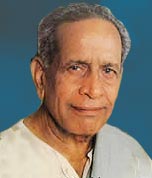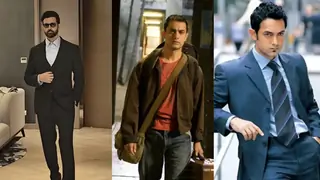Pundit Bhimsen Joshi
Bhimsen Joshi, who is riding the crest of popularity and has ridden it for the last several years, is a musical marvel. His singing invariably provides listeners with a divine musical ex- perinea. Many of his rivals admit, though unwillingly, that today there is no other vocalist comparable to him in the entire nation.
Bhimsen, who is now in his 60s, has attained proficiency and fame that astound the musical world. His voice, like that legendary philosopher's stone, turns every note into a golden one. Billions of notes that have received the golden touch of his voice have been freely showered by him on the teeming millions of his fans. His unswerving faith in an intense devo- tion to his guru have been his keys to success.
Bhimsen was born into a Brahmin family of Gadag in Kar- nataka. His childhood was spent there. Even as a child he was crazy about music, to the chagrin of his father who desired that Bhimsen should get a sound education and qualify as a doctor or an engineer. But Bhimsen, neglecting his studies, pursued music instead. At last he could not control any more his yearning to learn music, and one day he ran away from home. He had heard that Gwalior, Lucknow and Rampur in the North were the best places to learn classical music. Therefore his first destination was Gwalior.
A few years of his youth were thus spent in the company of well known musicians at Gwalior, Lucknow and Rampur, serv- ing them and learning as much as he could from them. His father, coming to know of Bhimsen's fervent desire for know- ledge in music, abandoned his policy of opposition, fetched his son back and made arrangements for him to learn under the guidance of Sawai Gandharva of Kundol. This opportunity opened the vaults of rich and rare musical treasures to Bhimsen. Bhimsen's natural tuneful voice received further polish from his guru. Like a diamond which sparkles all the brighter after it is expertly cut, Bhimsen's voice began to shine with a new luster and brilliance which has dazzled and cast a spell on the entire country.
Maharashtra was then part of a province known as Bombay Presidency that included Dharwad, Belgaum and Bijapur, which are now parts of Karnataka. I therefore had to look after the recordings of artists in this Kannada-speaking region. As part of my duty I was required to go on tours of places like Bijapur. Belgaum, Bailhongal, Dharwad, Hubli and Gadag in search of fresh talent and recording material. During one such tour I came to know of young Bhimsen. Shortly afterwards, I got an opportunity to see him and hear him sing. A Kannada dramatic company came to Bombay to present Kannada plays. A show was arranged at the Podar College hall at Matunga, for the benefit of the Kannadigas residing in North Bombay. I did not know Kannada at all but I was prompted to go with the purpose of hearing young Bhimsen on stage. Bhimsen was the hero in the play Bhagyashri. When I heard him sing I was convinced that the young man was a miracle, a genius, god's own creation, and would have a brilliant future. Even though Bhimsen's classical singing had not yet reached a high standard, his style of presentation greatly impressed me.
I immediately negotiated with him for an H.M.V. recording. He sang two Hindi and two Kannada bhajans for his first re- cording. This was in the year 1944. Soon afterwards I got him again and this time he recorded a beautiful poem Uttar Druv Dum composed by the well known Kannada-Maharashtrian poet the late D. R. Bendre, and also another poem written by the Kannada poet laureate Puttappa in bhavgeet style. With the great success of these recordings, which sold in very large numbers in Kannada areas, Bhimsen began to cut more and more records. By this time he had made the grade as a classical singer, so I got him to do a few classical pieces, which also were a great success. Thus, gradually Bhimsen became well-known and popular as a singer.
With his increasing popularity Bhimsen started getting invita- tions to sing at various cities and towns in Maharashtra and Karnataka. To facilitate the keeping of these engagements, he now bought a big car and took to driving. The car was so big that it could easily accommodate him and his 4 accompanists besides two tanpuras and other instruments. In this car Bhim- sen traveled extensively. One day he would go from Bombay to Belgaum - then on to Bangalore the next day, and back to Pune- only to go off again to Nagpur, Raipur or Bhilai. Back again in Pune, he would rush off to Hyderabad, Solapur and so on these whirlwind tours became a habit with him and in a short while he became an expert driver.
His unbelievably flexible voice enabled him to traverse at terrific speed, the great range of 3 octaves. While at the wheel, he used the same technique as in singing. He ignored the possi- bility of danger from bad or slippery roads, ditches, pot holes and other obstacles such as oncoming cars and stray cattle. Only fabulous luck saved him from a couple of very grave accidents. This toned down his recklessness. Another factor also lessened Bhimsen's craze for fast motor driving. The spread of his fame and popularity beyond the boundaries of Maharashtra brought him invitations from far off places like Jullundur, Jammu, Sri- nagar, Delhi, Calcutta and Gauhati. Bhimsen, who had so far matched the speed and agility of his voice with the speed of his car, realized that a car after all has limitations and moves in the vilambit laya. As he began to accept numerous invitations to far off places (he would have to be in Calcutta one night, Delhi the next evening, Bombay the following day and Jullun- dur immediately afterwards), he had to switch to air travel. The pilots of Indian Airlines and airport officials came across Bhimsen so frequently that he was soon known as the 'flying musician of India'.
Sometimes as I sat at my table in the office, the phone would ring 'Hello Govindrao! This is Bhimsen. I am coming to Bombay by the morning plane. I have to go to Calcutta by the afternoon flight, please book my seat.' At other times, Bhimsen would rush into my office unannounced and explain, 'Had a program last night in Delhi. I have just arrived by the morning flight.' ' Now I am off -to Pune but will be back to- morrow because I have an engagement in Calcutta the day after.'
One can easily imagine the tremendous difficulties involved in getting hold of an ever-busy singer like Bhimsen for recording. Fortunately as his popularity increased rapidly, the recording technique also improved for the better. 78 R.P.M. records were now replaced by the 45 R.P.M., extended play records and 33 R.P.M. long-playing records. Extended play records played twice as long as the 78 R.P.M. So the prices also were double. The long-playing microgroove records were also proportionately higher priced. These records gradually became the exclusive privilege of the affluent in society. Therefore I felt it would be a commercially profitable venture to cut EP records instead of LP records for some time. Accordingly I got Bhimsen to sing on EP discs. These included Zanak zanakuva in Raga Darbari. Piya to manata nahee, a thumri, Jo bhaje hari ko sada, a bhajan, and the most enchanting thumri - Piya ke milan ki aas. These records, when released, surprisingly and contrary to my expectations, did not show good results. I could not imagine what had gone wrong. After making a study of the psychology of the customers, I realized that those who were able to buy EP records were usually fairly well-to-do and they could easily spend the extra 20 to 25 rupees for an LP record. They would rather buy an LP with a full 20 minute cheez; or a raga, than an abridged version of the same on an EP record. So I decided to put Bhimsen on LP records. I got him to do the same Ragas, Todi, Darbari and Malkauns, which he had previously sung for EP recordings, and these were a fantastic hit in the market. My guess that people loved to listen to ragas sung by Bhimsen in their full form and splendor proved to be very correct.
Every performer has his favorite items, in which he excels. On the strength of these- his mehfil becomes a memorable experience. Bhimsen is no exception. After hearing a number of his concerts some people remarked that his programs are repetitive. It is a peculiar characteristic of our music that the ingenuity of a musician is known by his ability to unfold and create new and novel facets of known raas. The same com- position, same notes in the same ragas, presented on successive occasions can sound ever-new, fresh and enchanting and receive enthusiastic approval from listeners and critics in the audience. It is very necessary therefore that the listeners should cultivate a knowledgeable interest and a musical ear to appreciate our classical music.
I had got Bhimsen to record most of the ragas over which he had full command. After a year and half he appeared to be reluctant to cut new discs. One day as we were chatting, I told him to do some more recordings and he said, 'To tell you the truth, I really do not know just what to record now. I have already come out with most of my winning numbers. If I make fresh recordings, they must have the same superior stamp of quality and performance.'
I admired him for the candid statement. I said, 'All your fans are waiting eagerly for you to come out with new things. Surely you can think of something if you apply your mind seriously to it.' He merely smiled and promised to do so. Soon after this my niece got married in Pune. Bhimsen was invited with his family to the ceremony and the lunch there- after, but to my disappointment he did not show up. In the evening he came with his wife to the reception. He knew imme- diately that I was a little annoyed at his failure to come for lunch. 'We had a lot of guests today,' explained his wife. 'That's why we could not come.'
I said, 'Since you failed to come you will have to submit to some punishment.' He agreed. 'What is the punishment?' I announced, 'There are two, to be undergone one after the other. First - you must finish all three dishes set before you, and second - you must sing for us in the hall tonight.' Bhimsen sportingly accepted both the punishments. In his performance that night he presented two entirely new ragas which I instantly liked. Even though he was not yet very familiar with the raga composition, I could well imagine how marvellous the exposition would sound once it was perfected. There and then I decided to have the new ragas for his next recording. One was an admixture of Kalavati and Rageshri (he had aptly named it Kalashri), and the other was a beauti- ful fusion of ragas Lalit and Bhatiyar. The recording of these however could not be done before I left in July 1970 on an extensive trip around the world.
I returned after a period of 7 months and although I had offi- cially retired from service I was prevailed upon to work for the company again in the same capacity. As a matter of fact I did not need to work any longer. Both my daughters were happily married; my responsibilities were over. There really was no need to saddle myself with a job, but I had been so used to working and to having the company of artists for so many years, that without these my life would have been purposeless and monotonous. Hence I agreed to the proposal in March 1971. Bhimsen had remained unrecorded for nearly 3 years so I decided to get him as the first artist after my reappointment.
I realized once again the truth that a genuine artist values friendship more than money. In just a month after I resumed, I brought Bhimsen to the studio. He had agreed to make only one record that night. The news that Bhimsen was in our studio leaked out, I don't know how. I suppose one cannot hide frag- rance. That night a number of artists arrived in our studio to listen to Bhimsen's recording. Prominent among these were veterans Kumar Gandharva and Sudhir Phadke. Sometimes the presence of such knowledgeable colleagues is helpful. The singer, inspired by the presence of such stalwarts, strives tc give his best. But at times such a presence has an adverse effect, too. In a mehfil a singer wanting to fulfil the expectations of the listeners has ample time and opportunity to show his prowess, but during a recording session a singer has to present a complete picture of a raga, in a most delectable form, in a short duration of time. Therefore, while trying to do this the singer may come to regard the presence of such knowledgeable friends as akin to that of a bunch of jurors. When he gets into this agitated and perturbed state of mind a coherent performance becomes very difficult.
The recording session began at 9.30, but till midnight Bhimsen was tossing adrift in the cross-currents of notes of the raga Gaud Sarang. I therefore called for a coffee break. The distinguished guests, sensing Bhimsen's predicament discreetly left, and after some time we resumed the session. Now released from ten- sion, Bhimsen, having already warmed up sufficiently, started with a bang and gave a very scintillating exposition of Raga Gaud Sarang. The replay of this recorded side had an electrify- ing effect on Bhimsen, and he who had struggled for over three hours with the notes of a single raga, recorded in succession five more ragas with his uncanny and astounding imaginative skill and rare artistry.
The session that had begun early in the night came to a close at 7.30 the next morning with six brilliant ragas to Bhimsen's credit. An artist, when he gets into his element, is oblivious of everything except his art. Bhimsen had come with the tacit understanding that he would cut only one LP but had ended up recording material enough for three LPs. Besides the traditionally known Gaud Sarang, Brindavani Sarang, Puriya and Durga, he immortalized Ragas Kalashri and Lalit Bhatiyar, both of his own creation, which I had, as mentioned before, earmarked for re- cording during his performance in Pune.
While trying to persuade Bhimsen to come for the recording I had strongly urged that he should also render devotional Marathi items, like his previous hit seller Indrayani kathi, for recordings on extended play. Bhimsen had already, through his regular concerts, made popular some more bhaktigeets, which received a terrific response. After that night's marathon session I did not dare to even mention the proposal for these devotional recordings. But, as if reading my mind, and pleased with his splendid innings of that night, Bhimsen said to me, 'Well, shall we make Marathi devotional EPs also?' Would I have said 'No'? We fixed the recording for that afternoon. Feeling doubly blessed and very elated, I immediately requested our recording engineer and other staff to come back to the studio by 12.30. Before parting Bhimsen promised to come to my residence to pick me up. Punctually at 12.30 Bhim- sen was standing at my door. His boundless enthusiasm filled me with admiration. Even before our recording engineer and other staff arrived we were ready with the tanpuras tuned. The night long riyaz had given such a brilliance to Bhimsen's voice that by the evening, instead of two, he recorded four Marathi bhaktigeets. At my own very first recording I had recorded four- teen songs instead of two. The late Panalal Ghosh made one LP and four EPs in a single night, but Bhimsen broke all pre- vious records by cutting six sides of 20 minutes each and four sides of 7 minutes each within a short period of 20 hours. Such a splendid performance was possible only for a stalwart like Bhimsen. All the senior officers in our company were astounded by this unbelievable feat.
For the previous 3 years the company, the trade and his fans had eagerly awaited the issue of new LPs featuring Bhimsen. I had succeeded in obtaining for them 3 LPs topped with a bonus issue of 2 EPs in just 18 hours. I was congratulated on this unique achievement, but I give all the credit for it to this giant gem of an artist.
Supreme confidence in his own abilities and unfailing loyalty are two prominent qualities of Bhimsen. Every year he observes the punyatithi (death anniversary) of his guru Sawai Gandharva with a music festival at Pune. Those privileged to attend it are indeed very fortunate, for the spectacle is one fit for the gods. For three consecutive nights about 10,000 people attend the program from 8 at night to 7 the next morning. Eminent artists in the world of Indian classical music vie with each other for a chance to appear on the stage on this occasion. There are two reasons for this. Firstly the program is at the behest of a great fellow artist like Bhimsen, and secondly it is rare and almost impossible for a musician to get a chance to perform before such a vast, discerning and appreciative audience. During these celebrations, Bhimsen works like an ordinary volunteer. On occasion he is even noticed sweeping the stage, bringing the instruments on stage and helping the artist to tune the tanpuras perfectly. He looks after the comforts of the artists and audience alike. He does this untiringly for three successive nights. One cannot help but admire him for his love and reverence for his guru.
I had made a number of 3 minute records of the late Sawai Gandharva in his life tirne. From these I selected 12 songs to form one LP and got it released during the memorable 1969 session of his anniversary arranged by Bhimsen. The late Sawai Gandharva was a disciple of Abdul Karim Khan. A galaxy of veterans are among his disciples. They include top names like Gangubai Hangal, Hirabai Badodekar, Phiroz Dastur and Bhimsen, who is the youngest of them all. The characteristics of the Kirana gharana are precision-oriented tunefulness (lagav of swaras) presentation of a bandish with an impressively grace- ful style, and a disciplined, systematic and methodical raga de- velopment, punctuated with an elegantly elaborate alap and skil- ful decoration with the choicest forms of embellishments - taans. With the help of all these, Bhimsen makes such a terrific favourable impact on his audience right from the start of the concert that listeners remain glued to their seats till the last notes of his Bhairavi. Within a few minutes of his arrival in a concert hall Bhimsen measures correctly the pulse of the audi- ence. His discerning eye unfailingly recognizes the knowledge- able in the congregation and, by the time the tanpuras are tuned, and accompaniment arranged, he has decided on the musical menu he will dish out to achieve a resounding success.
Bhimsen fully understands mass psychology. He gauges the intellectual level of the listeners within minutes of the start of the mehfil and arrives at the point of sam in a totally unexpected and startling but graceful style to receive their spontaneous en- thusiastic 'Wah, wah'. From then on the mehfil is under his control and, for the listeners, it is a delectable treat which carries them to celestial heights. He has made a very careful study of where and how to utilize the beautiful phrases he has pre- selected. Because of this his elaborations never appear artificial. On the contrary his performance proceeds in a most natural and lucid style. He is blessed with an extremely sweet, flexible voice and with grueling riyaz he has trained it in such a way that he can always achieve the musical effects he desires. His voice, at one moment flowing smoothly like a tranquil stream, suddenly takes a mighty leap of two or more octaves in the next avartana and then, with gradually diminishing vigour, reverts gently back to sam, thus providing moments of supreme artistic pleasure. Bhimsen's recitals are replete with many such beauti- ful moments. His full-throated voice can at his command take on a soft velvety texture, to the extreme delight of the listeners. Like an airplane on a joy-ride, he flits from one octave to an- other, from there to the next, back again to the second and again to the third, all in one breath. The listeners hold their breath in an agony of suspense, marveling at his capacity, and when he glides gracefully back to the point of sam, the entire audi- ence breathes a sigh of happy relief. Along with his artistry, this feat of physical endurance and breath control is most im- pressive. Bhimsen believes that in classical music the poetic content of the lyric is as important as thc notes of the raga. He becomes entirely absorbed with the sentiments of the bandish and this emotional merger is appreciated by listeners of all ages and levels. This is why Bhimsen's classical singing has mass appeal.
Bhimsen is a versatile singer; he is an expert in khayal singing but he is also adept in the presentation of thumris, songs from plays, or devotional compositions. His lilting thumris (Jadu bhareli, Piya ke milan ki aas or Babul mora) and his innumerable popular Abhangs composed by the saints of Maharashtra are instances in point.
Bhimsen is a prodigy - unique - a divine miracle. We should admire his tremendous accomplishments in the realm of music, revel in the heavenly experience of his gayaki and pray to God Almighty to bless this musical genius with a long life. In the whole of India there is no one else who has atained so much and given so much to music lovers. Listeners in he U.S.A. and the U.K. love and admire him. It is a pity that our Govern- ment has only bestowed a mere Padmashri on him, instead of the higher honours deserved by an artist of Bhimsen's calibre who has received the greatest acclaim abroad.










 Gifted with a deep and captivating voice and capable of arousing an audience like few other vocalists of our time, Pandit Bhimsen Joshi is a living legend in the world of Indian cassical music today.Bhimsen Joshi was born at Gadag in Karnataka, on 4th February 1922. For some time, his family seriously entertained ambitions of his becoming an academician. But he had other ideas. He had an obsession for music even as a child. He would spend hours at the local radio store at Gadag, listening to recordings of great singers such as Ustad Abdul Karim Khan. Such was his passion for music that eventually, he ran away from home
Gifted with a deep and captivating voice and capable of arousing an audience like few other vocalists of our time, Pandit Bhimsen Joshi is a living legend in the world of Indian cassical music today.Bhimsen Joshi was born at Gadag in Karnataka, on 4th February 1922. For some time, his family seriously entertained ambitions of his becoming an academician. But he had other ideas. He had an obsession for music even as a child. He would spend hours at the local radio store at Gadag, listening to recordings of great singers such as Ustad Abdul Karim Khan. Such was his passion for music that eventually, he ran away from home











